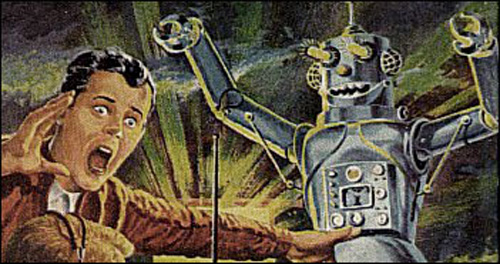Thu 24 Jul 2008
The Uncanny Valley
Posted by anaglyph under Creepy, Ooky, Philosophy, Robots, Science, Technology
[16] Comments

You may remember that in my post about the Coming of the Robots a little while back I talked about Hiroshi Ishiguro’s actroids and the inventor’s attempt to give his automatons a realistic human appearance. I penned the words:
…the closer these things come to having the semblance of humanness, the greater is my desire to punch them.
As I wrote in that post, my feeling is that there is something more disconcerting about the almost human appearance of these robots than there would be about having a clumsy metal quite obviously artificial ‘Robbie’ as a manservant.
Well I discovered today that there is in fact some interesting thinking devoted to exactly this idea, and even better, a cool term.
It is called The Uncanny Valley.
The Uncanny Valley hypothesis was advanced by Japanese roboticist Masahiro Mori and basically states that, as robots develop and become increasingly ‘human’ in appearance, humans start to find it easier to accept and interact with them. However, there comes a certain point beyond which acceptance gives way, quite abruptly, to revulsion. Then (Mori’s hypothesis asserts) as the facsimile approaches even greater realism (that is, the ‘ideal’ human form) acceptance increases once more to ‘human’ level tolerance.
If you viewed the videos of Ishiguro’s actroids you’ll understand exactly what the Uncanny Valley idea encompasses – these robots are creepy and disturbing and there’s no way I’d want one lurking in my house after dark. Or before dark for that matter. So much so that I’m even wary of Mori’s use of the term ‘Valley’ in his hypothesis – from where I stand it looks more like an Uncanny Grand Canyon.
Mori has been criticised on this very point – there is of course no evidence so far that robots will become sufficiently lifelike to make the Uncanny Valley anything more than an Uncanny Precipice.
In fact Mori’s whole concept has been called into question by commentators such as US roboticist and sculptor David Hanson and Swiss artificial intelligence scientist Dario Floreano* who go so far to say that it is pseudoscience. Well, it may be true that there is little actual science behind the idea of the Uncanny Valley as yet, but to my mind at least it makes good common sense that we instinctively don’t lend our trust to something that could be human but also might not be. It’s not a new concept to humans in any way – it has been the subject of paranoid science fiction for decades, and before that an idea that surfaces in folk tales and myths as far back as we have records.
As I said in We Are the Robots, when we used to have the old electronic ‘cut-up’ voices on telephone answering services, it was clear that we were dealing with machines. In my opinion, as superficial semblance to machines decreases (in these ‘voice robots’ at least) then we expect, quite correctly I think, that their behaviour should increase in realism at the same rate or better. And as much as I respect the obviously informed opinions of people such as Hanson and Floreano I think that the Uncanny Valley will persist until such times as robots are indistinguishable from humans.
In other words, when the androids get as convincingly lifelike as Rachel in Blade Runner, then maybe The Uncanny Valley might start to look more like a Grassy Meadow.
___________________________________________________________________________
*Floreano has an MA in Visual Psychophysics. Oh, how much do I want one of those!
___________________________________________________________________________
16 Responses to “ The Uncanny Valley ”
Trackbacks & Pingbacks:
-
[…] as we’re on the subject of the Uncanny Valley, lets drift over to the phenomenon of Reborn Baby Dolls. If you don’t know what I’m […]
-
[…] couple of posts back I mentioned Reborn Baby Dolls in the context of The Uncanny Valley and the problem of distinguishing robots from […]




Today’s pseudoscience is tomorrow’s kick-ass patent.
In any case, pseudoscience never stopped anyone from making a buck.
If you want an MA in Visual Psychophysics so badly, get one the same way you got ordained.
But if the robot is “female” and hot, would you have the urge to donkey punch her?
I always wondered about someone like Dors Venabili. I think this Uncanny Valley idea has a lot more use in understanding things like xenophobia and loyalty than for robotics.
Does this mean if God were less creepy, you’d let him in your heart and save your soul?
I swear I’m not high, but this post made me wonder that. It also led to the next thought:
What if God is a hot robot?
I can’t concern myself with robots climbing the putative Valley wall towards me – most actual humans don’t manage to crawl up out of the creek at the bottom, as far as I can tell.
I swear there are a lot of people out there who would fail a Turing test.
Call me misanthropic, if you will. I can take it.
Cissy Strutt: If only there was a Universal Life University of Psychophysics. Sigh.
Mike: I learn something new from my readers every day.
Casey: I think there’s probably a case for xenophobia, but Mori’s own hypotheses revolve around the idea that we instinctively shun people who appear ‘not-quite-right’ because they may be ill or mad and therefore dangerous. This makes a lot of sense to me. In my opinion Hanson and Floreano have come down rather hard on the idea primarily because it doesn’t fit in with what they believe, not because they have any science to the contrary. Hanson’s lifelike faces don’t make his robots any less creepy for me (I’m sure you’ve seen his ‘Einstein’), even if he likes to think so. And if you’ve ever spent any time with people with mental disabilities you can extrapolate very easily how unsettling a ‘not-quite-right’ robot would be. As I mentioned in the last post about this, we’ll tolerate a lot of variation in people, but my guess is we’d lose it very quickly with robots. I know I would.
Strangely, the thought of God as a hot robot makes a lot more sense to me than most of the currently held concepts.
JR: I’ve long suspected that some of The Cow readers are AIs. Not saying who. Let’s just say I’ve got a Turing Test Results Form here and the numbers are scary.
Are you sure you are not John Conner?
Ah, Rachel. Teen crush.
Malach: Hmm. Good thought. But I rather think I’m Magnus…
John: Well, I can’t quite say ‘teen’, but I hear ya.
did you see the movie, Lars and the Real Girl? I think the robot (doll in that movie) absorbs realness from its owner. The more you believe your robot is real, the more others will accept it as real.
Hmm. Interesting argument FL, but I think if we all attempted to do what Lars did, we’d end up having a few serious societal problems…
LATRG is more about the acceptance of the behaviour and emotional landscape of people than it is about the doll. I have no doubt that people anthropomorphise their dolls and their teddy bears and so forth, and there’s nothing wrong with that, but the situation is very different for robots I believe. The Robot Makers are attempting to reach a situation where we not only accept them, but trust them. There’s a long way to go…
Yeah it’s like that robot that “replaced” our friend Peter Gifford some ten years ago now. I know I should be more open minded, but I still don’t trust it, even though it’s proven to be superior to the original in virtually every way.
The King
hi, andar here, i just read your post. i like very much. agree to you, sir.